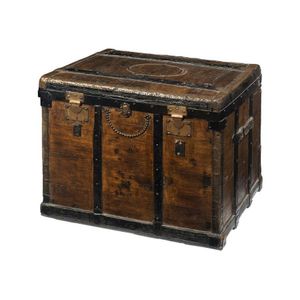Huanghuali Portable Table Cabinet with Carved Flower Design
You must be a subscriber, and be logged in to view price and dealer details.
Subscribe Now to view actual auction price for this item
When you subscribe, you have the option of setting the currency in which to display prices to $Au, $US, $NZ or Stg.
- Quatrefoil - A stylised four-circle design, itself contained within a larger circle, with Gothic origins and often seen as window designs in ecclesiastical architecture. The use of the motif was popular in Gothic Revival furniture of the 19th century.
- Ming Dynasty - The Ming Dynasty was a ruling dynasty of China from 1368 to 1644. It succeeded the Yuan Dynasty and preceded the Qing Dynasty. The Ming Dynasty was established by Zhu Yuanzhang, a former Buddhist monk who became a rebel leader and eventually overthrew the Mongol Yuan Dynasty. During the Ming Dynasty, China experienced a period of relative stability and prosperity. The government was centralized and bureaucratic, with the emperor at the top of the hierarchy. The Ming Dynasty is known for its cultural achievements, including the development of porcelain, the invention of movable type printing, and the construction of the Great Wall of China.
- Foliate - Decorated with leaves or leaf-like forms.
- Circa - A Latin term meaning 'about', often used in the antique trade to give an approximate date for the piece, usually considered to be five years on either side of the circa year. Thus, circa 1900 means the piece was made about 1900, probably between 1895 and 1905. The expression is sometimes abbreviated to c.1900.
- Huanghuali Wood - Huanghuali is the most sought-after timber used in the construction of Chinese furniture because of its fine colour and grain.
During Ming and early Qing dynasties, most of the best furniture was made from huanghuali wood.
It is a member of the rosewood family and over time the surface mellows to a yellowish brown tone with the exposure to light.
In recent years, furniture made from huanghuali wood has increased exponentially in value. - Qing Dynasty - The Qing Dynasty was the last imperial dynasty of China, ruling from 1644 to 1912. It was established by the Manchu people, who originated from the northeastern region of China. The Qing Dynasty was preceded by the Ming Dynasty and followed by the Republic of China.
- Zitan Wood - Zitan is the most expensive, and since ancient times, has been considered the most precious of woods.
Zitan wood is the hardest and heaviest of all hardwoods. It is purplish-black to black in colour, and with a grain so dense it is virtually invisible.
Zitan can usually only be obtained in quite narrow strips and so it is rare to find large pieces of furniture made from this wood. True Chinese rosewood is a variety of zitan and is very rare.
This item has been included into following indexes:
- Chinese furniture, chairs - chairs, Qing dynasty 347
- Chinese furniture, tables - table top cabinets 14
-
Chinese furniture, timbers
- huanghuali wood 159
- huanghuali wood, tables 49
- zitan wood 34
-
Chinese furniture, type or function
- chests and trunks 289
- storage cabinets 629
Visually similar items

A hardstone inlaid hongmu table cabinet, Guanpixiang, the hinged gabled cover lifting to reveal a shallow compartment above two pairs of short and one long drawer, the sides with bail handles and a chain on one side joining the cover and side, the cover de

A hardstone inlaid hardwood portable chest, Guanpixiang, the domed cover with ruyi -head metal fittings, above a pair of doors opening to reveal two pairs of short and one long drawer, the sides set with bail handles and a chain joining the cover and side,

An Australian miniature travelling trunk, painted pine with rope handles, 19th century, 23 cm high, 40 cm wide, 27 cm deep

A brass and metal mounted travelling trunk, French, early 19th century, stamped D.Jne_Brevete 8.G.D.G, 64 cm high, 76 cm wide, 52 cm deep
